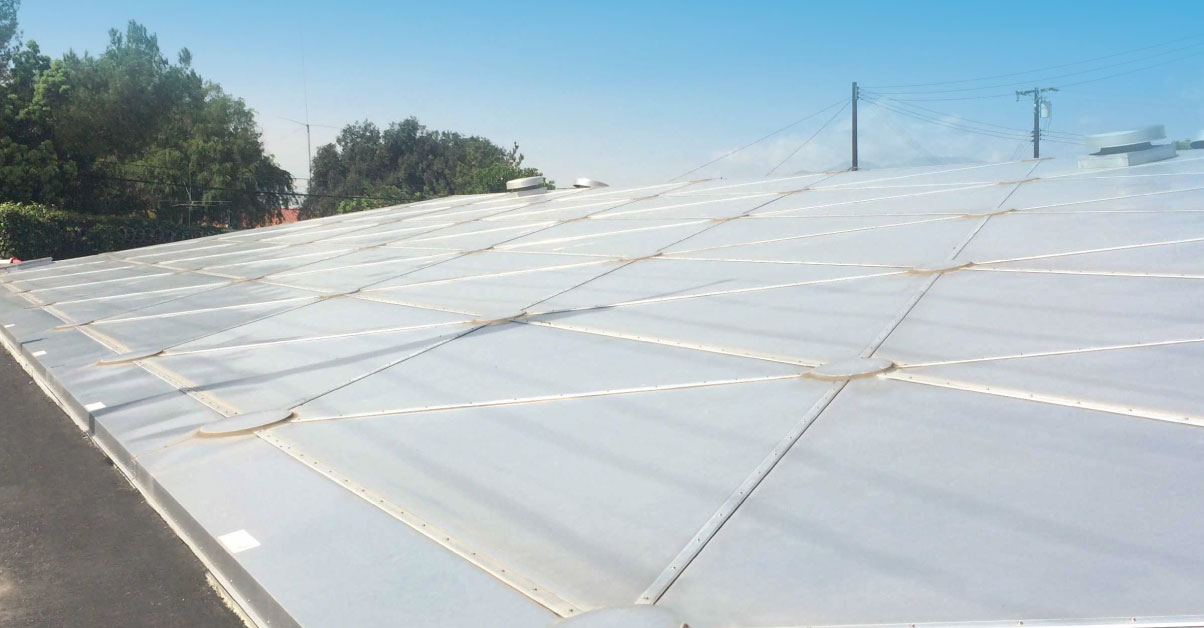
Reservoirs come in all shapes and sizes, but that doesn’t deter the professionals who specialize in municipal water projects. Just ask the team that upgraded Cypress Street Reservoir in Covina, CA.
Situated in the San Gabriel Valley about 20 miles east of downtown Los Angeles, the city of Covina serves nearly 50,000 residential water patrons plus hundreds of businesses, and “strives to provide … the highest quality water, reliable service, and competitive rates.” 1
When it was founded at the turn of the last century, Covina was small. A resident came up with the motto “One Mile Square and All There,” and that could describe Cypress Street Reservoir. Built in 1896, the reservoir is actually two end-to-end basins – one round and one rectangular – tucked snugly into a residential neighborhood. That configuration created special challenges.
“Because of the limited work space, we created a special sequence for demolition and construction and carefully organized the delivery of materials and equipment,” says Barry Matchett, Tank Division Manager at Spiess Construction, the general contractor. “Access to the site was also a challenge due to the high tension overhead power lines along Cypress Street, so we had to position cranes inside the perimeter fence.”
With so many unique features and requirements, collaboration among contractors and engineers was critical.
“The challenge for us was dealing with the seismic connections between the roof structure and the basins,” says Terry Kerger, Principal Engineer with Civiltec Engineering. “The seismic integrity and reinforcing of the old tank walls was unknown. Spiess Construction came up with the roof design loads and structural reinforcing to transfer the seismic loads from the roof into the foundation of the tank.”
“We transferred the seismic loads by constructing seismic shear walls connecting roof load plates to the foundation of the tank,” says Matchett. “Footings were placed on the inside the reservoir and a walkway was built on the inside perimeter.”
The project also included upgrading electrical controls and SCADA technology, replacing pipes and applying waterproof joints between walls and floor surfaces, constructing reinforced walls and pouring a six-inch floor to ensure the reservoir remains watertight.
“The basin floors were so thin that when they were drained, dirt was showing in some sections of the floor,” says Dean Dospital, Water Services Supervisor with the City of Covina.
A custom aluminum roof from CST topped off the project, replacing the deteriorated wood roof and conferring a clean contemporary look.
“The biggest challenge for us? In a word, geometry,” says Robert Ritchey, Design Engineer at CST. “The reservoir’s irregular shape required specialty fabrication and assembly of a cover that would span and protect both basins and have a low profile.”
Ritchey adds, “The client also requested easy access to electrical controls in the utility area separating the basins so we made special accommodations, including cutting down the entry step-over, which would normally be 12-14 inches, to about three inches.”
A CST aluminum roof can be designed and fabricated for any situation or configuration. Tight quarters? No problem. For the Covina roof, the framework was assembled and the roof skin installed one section at a time. That’s somewhat unusual, but not unexpected for the experts at CST, who have designed and supplied over 18,000 covers for architectural, environmental and industrial applications in over 90 different countries.
“We’ve been pleased with the durability and appearance of the CST roof,” says Covina’s Dospital. “There’s no concern about how it will withstand the elements and there’s virtually no maintenance.”
From potable water to agriculture to manufacturing, customers choose CST for the superior design, construction and commitment to quality ingrained in every aluminum cover solution:
- Corrosion Resistance: Aluminum is inherently corrosion resistant. It lasts the lifetime of a structure and doesn’t need to be painted or repainted.
- Low Lifetime Maintenance Cost: With no need to maintain a protective finish to prevent corrosion there are little to no maintenance costs.
- Clear-Span Capability: Aluminum’s lightweight characteristics allow for larger clear-span cover capability than structures made of steel, concrete and other materials.
- Fast, Low-Cost Construction: Creative design and lightweight components enable installation in 1/3 the time it takes to install other cover systems. Less time, labor and equipment reduces the total cost of installation.
- Design Flexibility: Aluminum’s excellent strength-to-weight ratios and creative component designs result in covers and structures that cannot be replicated with other materials.
- Aluminum is green: Not only are aluminum cover systems recyclable after their service life, but over 50% of the aluminum used in the cover systems is made from recycled aluminum.
“The project was delivered on time and under budget, which is a testament to the entire team,” says Matchett. “We do water projects up and down the West Coast and we like working with Civiltec and CST because they address challenges the same way we do – not by forcing a cookie-cutter solution but by analyzing the problem piece by piece and plotting the steps to the right outcome.”
CST Contact Information:
CST Industries, Inc.
Edgar Saenz
Regional Sales Manager
310-353-5162
esaenz@cstindustries.com
1 2016 Consumer Confidence Report for Drinking Water, City of Covina

